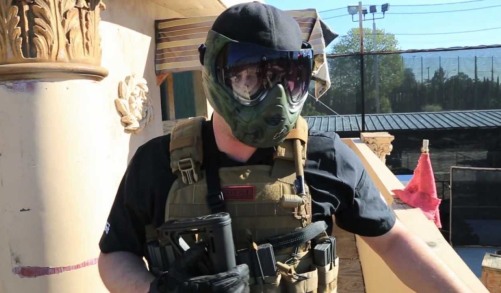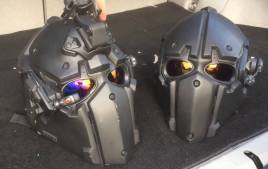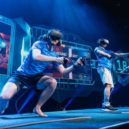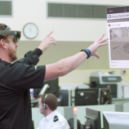AUGMENTED REALITY FOR POLICING

Augment means to accentuate, or bolster, bolstering the real world, akin to the way, the helmet sensors of Murphy in the movie “Robocop” receives and projects a stream of information on crooks and thieves into the field of his vision, prior to having them, blasted to smithereens , or Tony Stark’s accoutred Iron Man suit in the movie Iron Man 1, floating stacks of real-time data in the air in front of him,furloughing the charismatic death machine to bring about brutal demolition of the mercenaries , can be reckoned as “Augmented Reality (AR)”.
Luckily for us, this technology isn’t only confined to movies – it’s available for every aspect of life and work including policing. In 1990, Boeing researcher Tom Caudell first coined the term “augmented reality” to describe a digital display used by aircraft electricians that blended virtual graphics overlaid against the pilot’s cockpit screen.
Today this technology has come into civilian life, with car manufacturers such as Mercedes-Benz and Range Rover displaying vehicle speed and turn-by-turn directions directly on the windshield of a car. Google in 2013, released Google Glass which is a wearable, voice-controlled Android device that resembles a pair of glasses and displays information directly in the user’s field of vision.
 An augmented reality tool like google glass will immensely help visitors and native people gain a lot of knowledge and understand a place better. People donning them can be alerted while they are approaching a crime infested vicinage so that they don’t get robbed, or avert accidents while driving through an accident-prone spot.
An augmented reality tool like google glass will immensely help visitors and native people gain a lot of knowledge and understand a place better. People donning them can be alerted while they are approaching a crime infested vicinage so that they don’t get robbed, or avert accidents while driving through an accident-prone spot.
Let’s say a first time Russian visitor in Chennai, starts walking on the Marina Beach Road from lighthouse towards War Memorial, when he glances towards the sea and its beach his AR glasses would apprise him that Mountstuart Elphinstone Grant Duff, the governor of Madras from 1881 to 1886, was so captivated by the beach, that he extensively modified the beach with a promenade and named it Madras Marina in the year 1884. It would also overlay a display indicating that the beach which is 6 Km long is also the longest urban beach in the country.
As he glances left, it will point him to the majestic white heritage building and inform him that the once iconic Masonic lodge is today’s State Police Headquarters. As he continues to walk by it will enlighten him on the Triumph of Labour statue, the Gandhi statue in ‘march to Dandi’ stride, and other iconic statues such as Avvaiyar, Thiruvalluvar, Kamaraj, Kambar, Subramania Bharathiyar, Bharathidasan, Kannagi, the European Bishop Caldwell, G.U. Pope, Veeramamunivar, Anna memorial, MGR memorial as well as the memorials of two recent former Chief Ministers. If the visitor feels hungry, at a mere hint it will guide him to the most proximate restaurants with Yelp and Zomato reviews.
Similarly, a traveler approaching the airport to fly out will receive a pop-up alert of his flight status, and the gate which has been earmarked for his flight. Idea even incorporated AR into its catalogue back in 2013, allowing users to snap photos of couches or any other pieces of furniture with their smartphones and then place them in their own homes to see how they might look before actually buying. In future, AR will be the way we interact with the world around us and the lot, in particular, allowing us to query physical objects to better understand their history, intended use, and context.
What’s, even more, cooler is that companies like Google, Sony and Samsung have decided to get rid of the screens and lens barrier by putting AR directly on the eyeballs of humans just like the contact lens. Samsung is reported to have filed a patent for a device called “Blink” which beams images directly to the retina. The lens could overlay digital images onto our eye, for the quintessential augmented reality experience, and even record our surroundings for the ultimate self-voyeurism.
In the world of policing, use of AR is being accomplished by the use of wearable components to overlay virtual (computer-generated) information onto police officers real-world view or into their real-world experiences in a way that it improves and enhances their abilities to accomplish a wide variety of tasks and missions.”
A gazillion of sources could provide information for a fully interactive AR system. A police officer with a wearable AR component can access the data transmitted from a computer network wirelessly. AR brings together a wide diversity of technologies to display information to police officers in a way that it instantaneously applies to a given pursuit or circumstance, by using virtual graphics, three-dimensional maps, textual annotations, auditive information, and haptic (touch) sensations in a coordinated real-time presentation.
Some of the future law enforcement applications of AR could include, providing police officers with real-time intelligence about crimes and criminals in the purlieus , as well as facial, voice print and other biometric recognition data of known criminals to allow their instant identification.
AR will also support integration of chemical, biological and explosive sensors to instantly alert officers of any local contamination and recommend appropriate protective measures for themselves and the public. To police officers on patrol during foreign missions such as those of the United Nations, AR can provide real-time language translation combined with data on cultural customs and traditions.
It can provide advanced optics to permit investigators to lip-read from great distances in situations where listening to widgets are impractical. Police officers during SWAT situations and hostage negotiations could rely on AR for scalable three-dimensional building floor plans of criminal hideouts complete with sewer system design, to carry out successful operations along with public utility information and public transportation routes, to carry out successful operations. It has speech recognition capability to provide investigators with the ability to accurately match voices against known criminals.
The AR video, audio and sensing gadgets can be used to envision blood patterns, blood stains and other sensor-detectable forensic data available at crime scenes. Automatic sensor readings can calculate distance and height and directly create digital and AR maps for court presentation, as well as road traffic information on a heads-up display to make driving safer and more efficient, especially in pursuit and rapid response situations. AR can also be an effective tool for enhanced surveillance operation by coordinating the use of robots, unmanned aerial vehicles (UAVs), and satellite images.
Using the augmented reality technology engineers in the US have developed an Automatic Personnel Location System, which reveals the location of officers using the GPS signals sent by their wireless sets. If police are in hot pursuit of a criminal let’s say a kidnapper and if the police have a fix on his mobile number he can be tracked. If a police officer has already tagged the location of a suspect, this can be made visible to other police officers.
To help police officers, tracking targets via a helicopter, Churchill Navigation of Boulder, Colorado, USA, can augment live helicopter video with terrain-contoured street maps in real time. Without this, it would be hard for police officers looking at a labyrinth of streets on the screen to know which alley a target is on. It works by tightly coupling the map database to the software that controls the camera’s motion. Tying databases of information to a specific location provide rich, immediate understanding about that place and its history.
With Augmented Reality, a police officer can see through walls, into targets hideout for possible dangers, hazards, and its history before going in. Police also would be able to see what is happening behind the door, know past history of the address, including past emergency calls, and much else.
Drones coupled with Augmented Reality offer the capability for object identification, license plate recognition, and a number of other possibilities for law enforcement right down to the individual officer by creating a sophisticated tracking system of people, objects, and vehicles. In addition to object recognition drone data, feeds could identify suspicious movements in a crowd which might indicate a riot or a potential terrorist movement.
Some of the most difficult decisions a policeman may face occur in high-pressure situations when they are forced to make quick decisions. Trying to train for these types of situations can be complex. Advances in virtual and AR have made it possible to train police officers and security officers in real life situations to help them make split-second decisions in high adrenaline, high-pressure situations as well as to handle situations in different ways so that there are more positive outcomes.
Augmented reality applications are on the cusp of becoming truly mainstream. I shall in my next write-up explain how some countries have started implementing AR for crime investigation. Within the next decade, we are going to see an increasing amount of AR entering our daily lives. Therefore, we need to ask questions, whether it would then be possible for AR to project a spiritual reality for us as well? Or would it be possible for AR to deepen our spirituality by allowing us a vision of our spiritual dimension and by hastening our realisation? On the contrary, if AR is misused, it can create a population of controlled clones. You cannot control souls through technology, if AR comes close to creating such a situation, Spirit will surely intervene, of which I have no doubt.
Source from: epaper/deccanchronicle/chennai/dt:26.11.2018
 Dr.K. Jayanth Murali is an IPS Officer belonging to 1991 batch. He is borne on Tamil Nadu cadre. He lives with his family in Chennai, India. He is currently serving the Government of Tamil Nadu as Additional Director General of Police, DVAC.
Dr.K. Jayanth Murali is an IPS Officer belonging to 1991 batch. He is borne on Tamil Nadu cadre. He lives with his family in Chennai, India. He is currently serving the Government of Tamil Nadu as Additional Director General of Police, DVAC.


